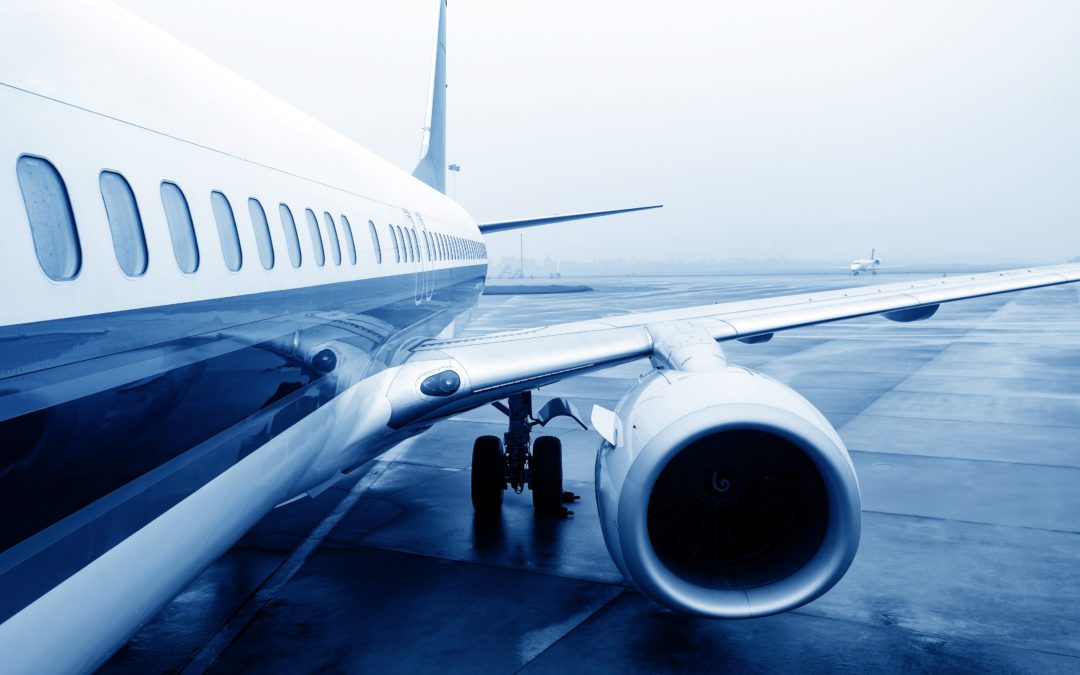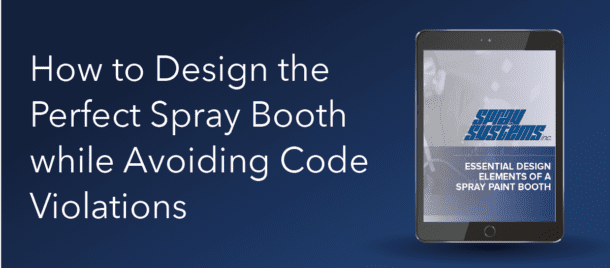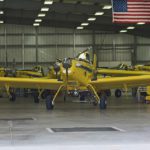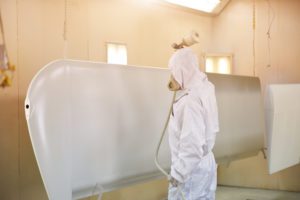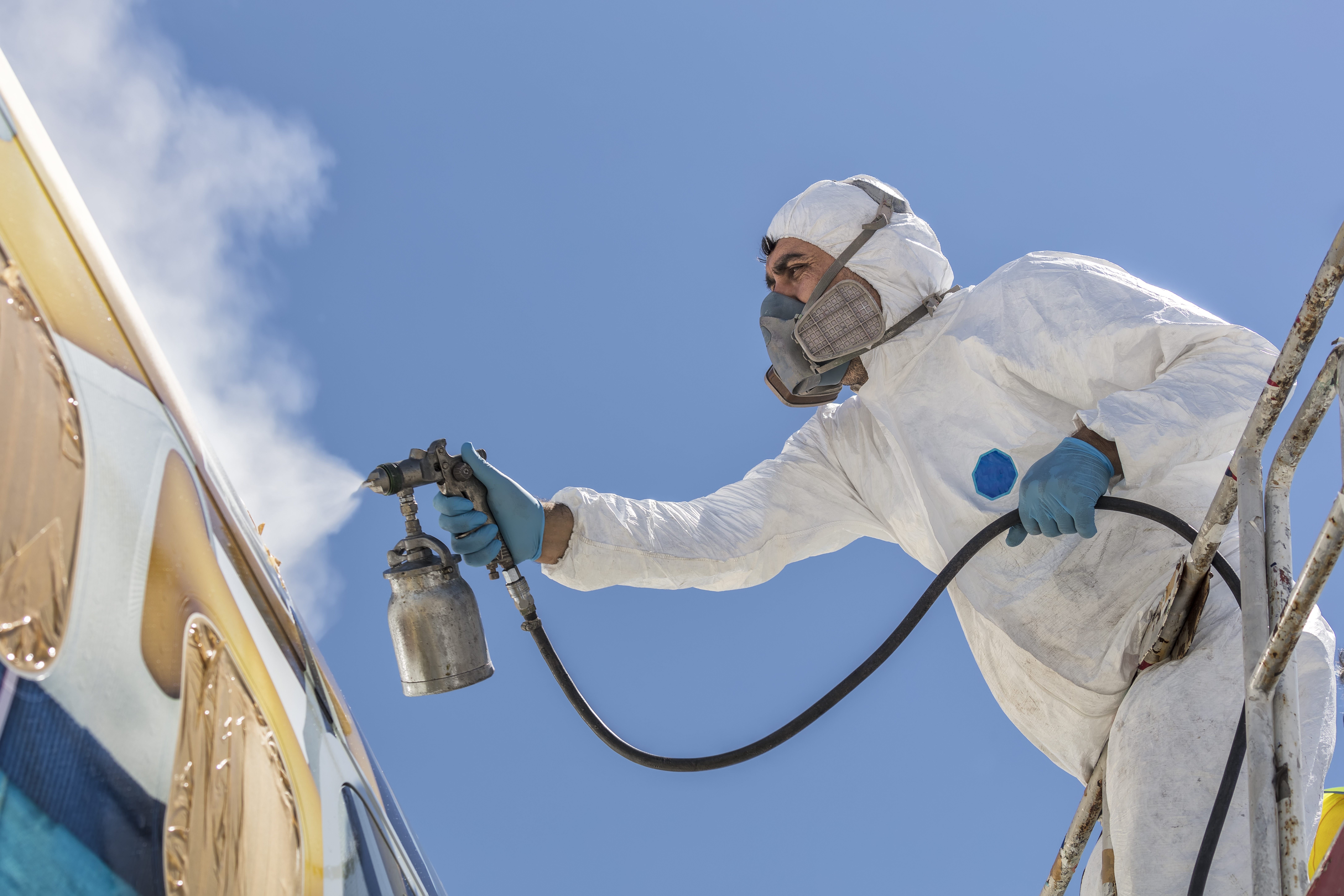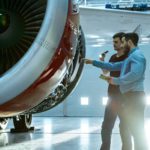Read Time: 4 minutes
Summary:
- Spray booths for the aircraft painting must meet several sets of strict regulations regarding operations and emissions, including NFPA, NESHAP and OSHA guidelines.
- The OSHA Standards for Spray Operations encompasses proper employee safety protocol for construction, marine and general manufacturing industries.
- NESHAP compliance requires strict monitoring and control of spray booth emissions and hazardous air pollutants (HAPs), like hexavalent chrome.
- The standards listed in NFPA 33 cover the use of flammable and combustible materials in all kinds of spray applications.
- Spray Systems can help you design a custom, efficient and fully compliant spray booth system.
Spray booths used by aircraft and aerospace component manufacturers not only need to produce precise and high-quality results consistently, but they also must meet several sets of strict regulations regarding operations and emissions. Operators face numerous considerations when selecting and optimizing spray booths for aerospace manufacturing facilities, which makes professional guidance and insight a valuable tool for decision-makers.
Notable Regulations for Aircraft Spray Booths
Modern spray booth operators are subject to the rules created and enforced by several regulatory agencies, including:
State and local agencies
Let’s take a closer look at these important standards as they apply to spray booths in the aircraft and aerospace manufacturing industry.
NESHAP
For aerospace manufacturers, the National Emission Standards for Hazardous Air Pollutants (NESHAP) defines many aspects of workplace operations. These standards were initially implemented with the Clean Air Act in 1970 and have been further developed in the decades since. NESHAP standards focus on hazardous air pollutants (HAPs), like hexavalent chrome, which are prevalent in aerospace manufacturing and treatment processes. NESHAP compliance requires strict monitoring and control of booth emissions, which makes advanced filtration systems a must-have when handling volatile or dangerous airborne chemicals.
NFPA
Even small faults or issues of mishandling in a spray environment can present a serious fire hazard in the workplace. This is why aircraft booth operators are also subject to rules created by the National Fire Protection Association (NFPA). The standards listed in NFPA 33 cover the use of flammable and combustible materials in all kinds of spray applications. NFPA requirements include sealing all unused containers holding flammable materials, safe disposal of cleaning rags and general workplace hygiene to mitigate fire risk.
OSHA
The Occupational Safety and Health Administration (OSHA) is a federal agency responsible for administering regulations regarding employee and workplace health issues. The administration maintains a list of detailed standards that state and local authorities use in their individual programs. The OSHA Standards for Spray Operations encompasses a variety of booth applications, including construction, marine and general industries.
Since employee safety is a key focus for OSHA regulations, the standards mandate that employers take basic measures to keep workers safe. This includes providing protective equipment, like respiratory and eye protection, as well as ample ventilation throughout the workplace.
State and Local
National standards often serve as a minimum guideline for state governments, which may enforce stricter regulations than federal agencies. All booth operators need to be aware of state and local laws that apply to them depending on their location. Failure to comply with any of these regulations can have serious financial and legal consequences.
Considerations for Quality
The numerous regulations applicable to spray booth operations aren’t the only factors worthy of consideration by operators or prospective buyers. Aerospace production processes are typically unforgiving of error. Paint and finish must be applied to near-perfection to ensure the component or vehicle functions properly. This means that aircraft booths must remain free of contaminants, even small amounts of dust, and operators need to be skilled and equipped to properly apply coatings. Lighting and ventilation are both critical concerns when designing and using spray booths, especially with spray booths for large aircraft, which require treating and filtering large volumes of air.
Picking Booths for Aerospace Applications
There are several general booth designs and dozens of different variations or modifications available to customize solutions to match the quality and regulatory requirements. The semi-downdraft design is among the most popular in the aerospace industry due to its ability to maintain high-quality results while offering flexibility to accommodate components of varying size, including entire aircraft. However, operators may still want to consider other designs depending on the nature, scale and location of their operations.
As a proud provider of top-end spray equipment for members of the aerospace industry, Spray Systems offers an extensive selection of advanced spray booths. Our professional team works alongside buyers to develop optimized systems that address their individual needs and concerns. We look forward to the opportunity to help our customers overcome regulatory and logistical challenges through innovative, customized solutions. Give our team at Spray Systems a call today at 800-736-6944 or complete the request a quote form.
